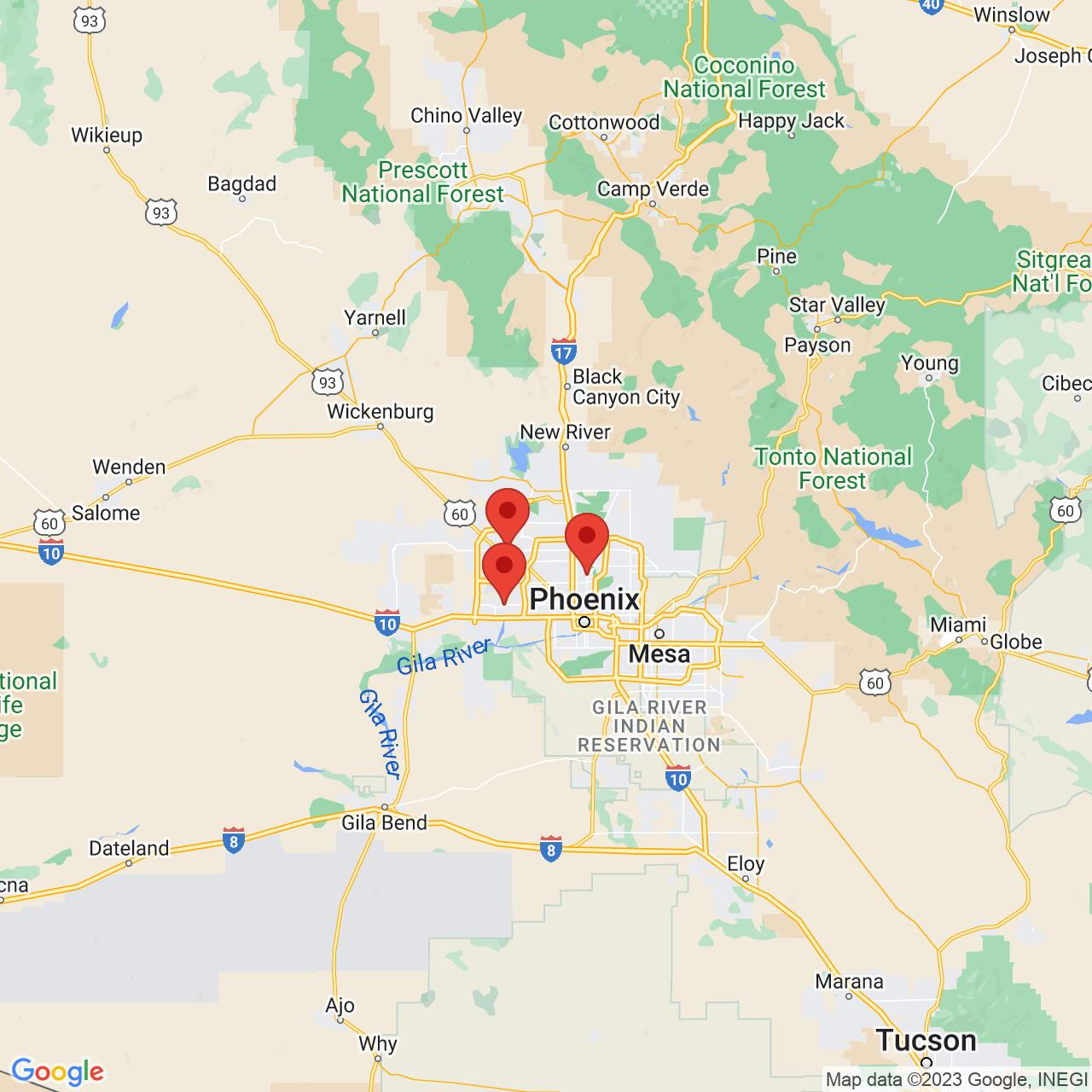
25+ YEARS EXPERIENCE • 99% SUCCESS RATE • $100+ MILLION RECOVERED
Arizona Car Accident Laws
If you’ve been in a car accident, it’s very important that you’ve received proper medical care and a full evaluation. Injuries that might seem minor could be more severe than they seem or lead to complications.
The following are some common car accident injuries:
- Head injuries. These are some of the most common car accident injuries, which can range from mild to severe. Injuries to the brain can be hard to diagnose. If you suspect that you’ve suffered from one of these common car accident injuries, you should seek treatment right away.
- Broken bones. These common car accidents are the most obvious and often the most painful.
- Back injuries. This common injury from a car accident can result in serious nerve damage, paralysis, and even death.
- Neck injuries. Because they can happen at very low speeds, neck injuries are some of the most common car accident injuries. Symptoms include pain, neck stiffness, and headaches.
- PTSD. Some of the most common car accident injuries can’t be seen with the naked eye. Serious car accidents can be traumatic events, and this trauma can cause all kinds of psychological damage. If you suspect that you might suffer from this common car accident injury, please seek attention from a mental health professional.
It’s important not to feel guilty about being in a car accident. Arizona car accidents are quite common, and according to the state Department of Transportation, there were nearly 120,000 accidents in 2022. Simply put, accidents happen, and it’s important for us to move forward.
That being said, it’s also important to understand Arizona car accident laws. Many accidents are preventable, and understanding laws are critical to avoiding them.
Types of Arizona Car Accident Laws
When it comes to handling car accident cases, two primary Arizona car accident laws should be considered: Arizona Revised Statutes (ARS) Sections 12-542 and 12-2505.
ARS Section 12-542 establishes the statute of limitations of two years from the date of the accident or date of death in accidents that led to a fatality to seek financial compensation. That being said, there are a few key exceptions to this statute, particularly in cases where more severe injuries did not develop until later on in life.
ARS Section 12-2505 establishes the state’s law of comparative negligence, which states that accident victims can pursue partial compensation for damages even if they are partially at fault.
Arizona drivers are also legally required to show they can take financial responsibility for operating a motor vehicle. This is typically done by carrying auto insurance with the following state-mandated minimums:
- $25,000 for the personal injury or death of a single person in a car accident
- $50,000 for the personal injury or death of two or more persons involved in an accident
- $15,000 for property damage
While the state does not require you to carry uninsured (UM) or underinsured motorist coverage (UIM), which covers medical bills if you’re in an accident with someone who does not carry mandatory minimum insurance, UM and UIM policies must also cover the mandatory minimums according to the Arizona Department of Insurance and Financial Institutions.
There are also a few Arizona laws related to car accidents that drivers in the state should know. Effective starting in 2021, the use of a cell phone while driving is seriously limited. Although cell phone laws were passed years ago in many other states, Arizona lawmakers hadn’t passed laws banning texting or using smartphones while driving until very recently.
Under the law, drivers cannot hold a phone, including between the cheek and shoulder, read, write, or send texts, watch videos, or record videos. Drivers are still allowed to swipe a phone briefly to accept or make a call, use a wearable device to talk on the phone, use voice commands, follow navigation functions, or call 911. Drivers are also allowed to use a cell phone while stopped at a light or stop sign.
Arizona had been a free-for-all for distracted drivers, and sadly, it took a number of tragedies for this distracted driving law to get past. As a family-oriented law firm, we look forward to this law saving countless lives and preventing so many tragedies. Breaking this law could result in fines of between $75 and $149. Also, if you are seen breaking this law, it gives the police officer grounds to pull you over for a traffic stop. Simply put, if you want to avoid a run-in with the Law, don’t text or use your phone irresponsibly while driving.
It’s also important to note how Arizona car accident laws are typically interpreted by the state’s legal system. For example, if you collide with another vehicle from behind under normal driving circumstances, you are more likely to be seen at fault than the other driver. The other driver may be found liable if it can be shown that they acted irresponsibly. If they stopped suddenly in an active traffic lane, backed into your car at a traffic stop, or had malfunctioning brake lights, then they are more likely to be found to be liable.
Drivers who get into an accident while making a left turn are also more likely to be found liable. Under state traffic laws, drivers should only turn left at an intersection when there is a safe amount of distance between their vehicle and other vehicles. This puts the onus on the car making the turn, and if turning causes an accident, the person making the left turn will be put under the microscope. Obviously, you can’t go around avoiding left turns, but it’s important to be aware of how the legal system sees them and take extra precautions accordingly.
Reporting an Accident in Arizona
In Arizona, it isn’t necessary to report every single minor scrape or low-speed fender bender. However, law enforcement must file a written report if an accident involves an injury, a fatality, property damage of more than $1000, or a traffic violation. People involved in an accident, regardless of how severe it was, must stay on the scene until they can exchange information. Anyone leaving the scene of an accident could be charged with a misdemeanor or felony hit-and-run violation, depending on the severity of the accident.
Arizona’s Comparative Negligence System
Some states follow a “no-fault” system for car insurance claims. Under this system, drivers involved in an accident must first make a claim on their own coverage, regardless of whether they had a hand in causing the crash.
Arizona isn’t one of these states. Under Arizona law, determining financial liability for common injuries from a car accident, property damage, and other losses is established by a fault-based system. So, if you single-handedly cause an accident in Arizona, you are on the hook for any harm you might have caused, and your insurance will have to cover the costs up to your coverage limits.
Determining negligence gets a little bit more complicated when a single driver doesn’t cause an accident all by themselves. Under Arizona’s “pure comparative negligence” system, drivers can recover damages based on the percentage to which they were at fault. Theoretically, this means a driver who was found to be 99% at fault for an accident can still recover 1% of total damages from the other driver.
Suppose you’re in an accident and sustain $20,000 in damages. If you were found to be 75% fall and the other driver was found to be 25% at fault, then you are only entitled to receive $5,000 from the other driver’s insurance company.
Statute of Limitations in Arizona
If you are involved in a car accident in Arizona, there are some deadlines you need to consider. First, it is important to report an accident to both your insurance carrier and the insurance carriers of any other drivers that were involved. Insurance companies often have rigid deadlines for reporting an accident, and not promptly reporting an accident could lead to a company delaying or possibly denying your claim. Even if you’ve suffered very minor and common injuries in a car accident, you should report it to your insurer right away.
It’s also important to understand the statute of limitations in Arizona, as outlined by statute ARS 12-542. If you suffer injuries from an accident, you have two years from the date of the accident to file a lawsuit against another driver. The families of victims killed in a car accident have up to two years from the date of death to file a lawsuit. If legal action isn’t taken within this timeframe, it likely means forfeiting the ability to recover compensation.
One exception is if a victim is a minor at the time of the accident. In this situation, the two-year limit does not begin until the minor turns 18 years old. Another exception is if a victim doesn’t discover their injuries until after two years from the date of the accident. However, the exception doesn’t apply if the victim should have noticed their injury and did not take action to treat it.
How Can Gerber Injury Law Help?
At Gerber Injury Law, we’ve seen all kinds of Arizona car accidents. We’ve seen common injuries from a car accident, and we’ve seen some unusual situations. Every accident is different, and we use our deep knowledge to help accident victims and their families.
We understand that even common injuries from a car accident can limit your ability to get around. That’s why we’re willing to visit you wherever you are to provide assistance. Contact us today to find out how we can put our experience to work for you.
Request Your Free Consultation
If you or a loved one has been injured, don’t hesitate – contact our attorneys today!
For bicyclist hit by car.
Phoenix Practice Areas
- Personal Injury Lawyer
- ATV Recreational Vehicle Accident Lawyer
- Bicycle Accident Lawyer
- Boat Accident Lawyer
- Bus Accident Lawyer
- Car Accident Lawyer
- DUI Accident Lawyer
- Rear-End Accident Lawyer
- Rideshare Accident Lawyer
- Self-Driving Vehicle Accident Lawyer
- Catastrophic Injury Lawyer
- Construction Site Accident Lawyer
- Dog Bite Lawyer
- Fatal Car Accident Lawyer
- Golf Cart Accident Lawyer
- Medical Malpractice Attorney
- Motorcycle Accident Lawyer
- Nursing Home Abuse Lawyer
- Pedestrian Accident Lawyer
- Premises Liability Lawyer
- Product Liability Lawyer
- Traumatic Brain Injury
- Truck Accident Lawyer
- Wrongful Death Attorney
- Arizona Car Accident Laws
- How Common Are Car Accidents?
- Common Car Accident Injuries
- Most Common Causes of Car Accidents
- Types of Car Accidents
- Car Accident Settlement Amounts
What Our Clients Say




